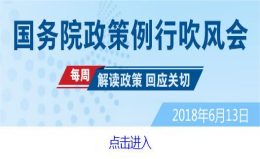The State Council's Notice on the Establishment of the Central Adjustment System for Enterprise Employees' Basic Endowment Insurance Fund Answered Reporters' Questions
Beijing, June 13 (Xinhua) -- Question: Official of the Ministry of Human Resources and Social Security answers questions from the press on the Notice of The State Council on the Establishment of the Central Adjustment System of Enterprise Employees' Basic Endowment Insurance Fund
Xinhua News Agency
Recently, The State Council issued the Notice of The State Council on the Establishment of the Central adjustment System of Enterprise Employees' Basic Endowment Insurance Fund, and decided to implement the central adjustment system of the fund from July 1 this year. An official of the Ministry of Human Resources and Social Security was interviewed by the press on relevant issues.
Q: Please brief us on the background of the Circular.
Answer: In recent years, the reform of Chinese enterprise staff basic pension insurance system has made great progress, the coverage is expanding, the number of insurance participants is increasing, the treatment level is steadily improving, pension insurance fund provincial overall planning system has been generally established, the policy system is constantly improved. However, with the accelerated development of the aging population and the diversification of employment, as well as the unbalanced economic development, the inter-regional dependency ratio gap is widening, and the unbalanced burden of the pension fund between provinces is becoming more and more serious. It is difficult to solve the problem by the provincial pooling. It is necessary to further improve the pooling level and moderate adjustment of the fund nationwide.
The CPC Central Committee and The State Council attach great importance to the national pooling of endowment insurance. "The Social Insurance Law of the People's Republic of China" stipulates that the basic endowment insurance fund gradually implements the national pooling. The report of the 19th National Congress of the CPC clearly calls for the realization of national pooling of endowment insurance as soon as possible. Because of the unbalanced level of economic development between regions and the wide disparity in pension insurance dependency ratio between different regions, there are still differences in pension insurance policy and treatment level. The provincial pooling system is not perfect enough to realize the unified income and expenditure of the fund in one step across the country. To this end, the CPC Central Committee and The State Council decided to establish the central pension fund regulation system as the first step to realize the national pooling. Recently, The State Council issued the Notice on the Establishment of a Central Adjustment System for Enterprise Employees' Basic Endowment Insurance Fund, and Premier Li Keqiang made important instructions on its implementation. On the afternoon of June 11, Vice Premier Han Zheng and Vice Premier Hu Chunhua attended a meeting on the implementation of the central adjustment system for enterprise Employees' basic pension funds and made speeches, making arrangements for the implementation work.
Q: What are the general ideas and basic principles of the Circular?
Answer: The general idea behind the establishment of a central adjustment system for pension funds is that, on the basis of not increasing the overall burden on society or increasing the proportion of pension contributions, we should establish a central adjustment system for pension funds to reasonably balance the burden of funds among different regions, ensure that the funds are safe and sustainable, the financial burden is controllable, and the pensions of all regions are paid on time and in full.
The Circular makes it clear that the central adjustment system of endowment insurance funds shall be established and the following principles shall be adhered to: First, fairness shall be promoted. By implementing unified central regulation and use of some pension funds, we will reasonably balance the burden of inter-regional funds and improve the overall anti-risk ability of pension funds. Second, clarify responsibilities. The central government provides subsidies through transfer payments and the central pension fund, and establishes a management system in which the central and provincial governments have clear responsibilities and are held accountable at different levels. Third, unified policies. After more than 30 years of reform and improvement of the endowment insurance system, the national unified basic endowment insurance system has been achieved, but there are still differences between regions in the contribution ratio, the verification method of the contribution base, the calculation and payment of benefits and adjustment methods, and other aspects. Through the implementation of the central fund adjustment system, it is conducive to the gradual unification of relevant policies across the country, and eventually the national unification of various endowment insurance policies. Fourth, we made steady progress. We will appropriately determine the proportion of funds raised by the central government, starting from 3% in 2018 and gradually increasing it in the future. We will further unify the operation procedures, establish a centralized information system at the provincial level, and constantly improve the level of management and informatization.
The establishment of the central pension fund regulation system is a major decision made by the CPC Central Committee and The State Council based on the current national conditions and the actual construction of the pension system. It is of great significance for enhancing the sustainability of the basic pension system, balancing the burden of the pension fund among regions, and promoting the equitable sharing of the basic pension rights and interests of the people.
Q: What are the main sources of the central adjustment fund? Will it increase the burden on enterprises and individuals and affect the benefits of retirees?
Answer: The central adjustment fund consists of the pension funds of each province. The implementation of the central fund adjustment system will not increase the burden on enterprises and individuals, and will not affect the benefits of retirees. First, we will not raise the proportion of contributions made by enterprises and individual employees. The central adjustment system for pension funds was established mainly to adjust surplus and shortage between provinces. The total revenue and expenditure of national pension funds for the current period did not change, and enterprises and individual employees did not need to make additional contributions, which did not increase the overall burden on society. Second, it does not change the current pension benefits planning and adjustment methods, will not affect the personal treatment of retirees. In some provinces, the amount of funds received is greater than the amount of funds allocated. In these provinces, the pension burden is relatively light and the fund support capacity is strong, so the adjustment will not affect the payment of the current pension on time and in full. In some provinces, the amount of funds allocated is greater than the previous amount of funds. Through adjustment, the pressure of fund payment can be properly eased and the basic pension can be better paid on time and in full.
Q: "Adjustment" is the core of the central adjustment system of pension insurance funds. How to achieve the goal of "adjustment" in the implementation process?
Answer: The purpose of inter-provincial "adjustment" is mainly achieved through the specific verification method of allocating funds from the central fund adjustment system. The Notice clarifies the calculation formula of the upper and lower amount of funds, and the verification method of related parameters such as the base of the upper payment, the number of the upper payment, the proportion of the upper payment, the number of the lower payment and the per capita allocation. The accounting method is simple and clear. Provinces with a high average wage of employees and a large number of insured and employed employees will receive more funds, and provinces with a large number of retirees will also receive more funds. Through the internal mechanism of the system, the adjustment of pension funds between provinces with relatively light pension burden and provinces with relatively heavy pension burden can be realized. It can achieve the effect that the eastern coastal provinces support the central and western provinces and the old industrial base provinces, and enhance the overall anti-risk ability of the endowment insurance system.
Q: The Circular calls for the establishment of a central regulatory fund. What are the standards for provincial and municipal authorities to regulate the funds?
Answer: The Circular makes it clear that the central adjustment fund consists of the funds from the pension insurance funds of each province. The base for calculating the upper settlement amount is 90% of the average salary of employees in each province and the number of people who should be insured on the job. The upper settlement proportion starts from 3% and gradually increases. The amount of each province and city is mainly determined by the salary and the number of people who should be insured.
The above salary is calculated as 90% of the average salary of the staff and workers in each province. Compared with the national average salary, the average salary of each province can better reflect the factors of local economic development. Regions with high salary level will also have higher upper salary, which is conducive to realizing the target of fund adjustment. At the same time, considering that the number of individuals participating in the flexible employment insurance accounts for about 1/4 of the total number of people participating in the insurance, the contribution base of these people is relatively low, and the upper payment based on about 90% of the average salary of the employees is more in line with the actual situation of different regions.
The number of insured persons shall be verified temporarily according to the average number of employed persons and insured persons at the initial stage. This approach takes into account both the target of expanding the coverage of the endowment insurance and the current reality. It can not only enhance the incentives for local expansion work, but also avoid "whipping the bull" in places with high insurance participation rate. To a certain extent, it can also eliminate the "inflated" factor of the number of local insurance participants caused by population flow. With the progress of the national insurance registration, the number of people who should be enrolled in the national insurance program will gradually be determined on the basis of the data of the national insurance program covering the permanent residents.
Q: How is the Central Adjustment fund managed and used?
Answer: The Circular makes it clear that the central adjustment fund is an integral part of the endowment insurance fund and has been incorporated into the special financial account of the central social security Fund. It is managed in two lines: revenue and expenditure, and special funds are used exclusively to ensure the safety of the fund. The central adjustment Fund is implemented according to the revenue and expenditure, and all funds raised that year are allocated to local governments. When allocating funds, the amount allocated per capita is calculated according to the total amount of adjustment funds raised and the number of retirees in the country, and then multiplied by the number of retirees in each region to calculate the amount of funds to be allocated. This is not only simple and clear, but also fair and unified. Provinces with a large number of retirees get more adjustment funds, which is conducive to helping some provinces with prominent aging problems solve the contradiction between fund revenue and expenditure gap.
Q: After the establishment of the central fund regulation system, how will the pension insurance responsibilities of the central and provincial governments be divided? Will local governments depend on the central government?
Answer: To implement the central fund regulation system, we must establish a sound incentive and restraint mechanism. If local governments try to "pay less and get more", it will increase the risk of system operation and go against the original intention of establishing the central fund regulation system to promote the sustainable development of the endowment insurance system. The Circular clarifies the responsibilities of governments at all levels and specific incentive and restraint measures:
First, the internal design of the system reflects incentives and constraints. The upper salary base and the number of people used to calculate the upper payment of funds are not affected by the actual income collected by various localities. The funds collected by various localities through efforts can be used in their own provinces, which reflects the encouragement to the localities where the expanded collection work is in place. At the same time, through the verification of the number of retirees, the fund expenditure management is not in place to reflect the constraints.
Second, it makes clear that provincial-level governments bear the main responsibility for ensuring that basic pensions are paid on time and in full and for making up for the shortfall in funds. After the central government issued the central financial subsidy funds and allocated the central adjustment fund, the provincial pension fund shortfall will be borne by the local government. Provinces and cities should consolidate their responsibilities at various levels, establish a sound mechanism for sharing fund gaps among provinces, cities and counties, and raise funds through various channels, such as putting existing funds to good use, disposing of state-owned property and arranging fiscal budgets, so as to solve the problem of fund revenue and expenditure gaps. Prior to the implementation of the central adjustment system of pension funds, the accumulated surplus funds of various localities are retained in principle to be used for the adjustment of pension funds within the scope of their own provinces (autonomous regions and municipalities directly under the central government).
Third, we will improve assessment, reward and punishment mechanisms. The work responsibility system of provincial-level governments will be assessed on the expanded collection and payment of pension insurance, the payment of basic pensions, strict fund management, and the implementation of the central fund regulation system. Provinces with good performance will be rewarded, and provincial governments and relevant responsible persons will be held accountable for problems.
Q: After the implementation of the central fund adjustment system, will the central government's pension subsidies be reduced?
Answer: No. The Circular makes it clear that the current policy and methods of central government subsidies will remain unchanged. In order to fully implement the policies on basic old-age insurance introduced by the state and ensure that basic pension benefits are paid on time and in full, the central government has vigorously adjusted the expenditure structure and continuously increased subsidies to local basic old-age insurance funds in accordance with the unified arrangements and requirements of the CPC Central Committee and The State Council. In particular, basic pensions for enterprise retirees have been adjusted for 14 consecutive years since 2005, and the central government has provided appropriate subsidies to the central and western regions and provinces with old industrial bases. In 2017, the central government provided more than 440 billion yuan in subsidies to local enterprises' basic old-age insurance funds, providing strong support to local governments in ensuring that basic pensions are paid in full and on time. After the implementation of the central fund adjustment system, the current policies and methods of subsidies from the central government will remain unchanged, and the intensity of subsidies will not be reduced.
Q: What measures will the Circular take to ensure the implementation of the central fund adjustment system?
Answer: Implementing the central fund adjustment system is an important part of strengthening the basic old-age insurance system and bears on overall reform, development and stability. The circular requires all regions and departments to unify their thinking, raise awareness, strengthen leadership, coordinate closely and meticulously organize implementation.
In order to ensure the smooth implementation of the central fund regulation system, we mainly adopt four guarantee measures: first, improve the provincial pooling system. All localities should accelerate efforts to unify the collection and expenditure of basic endowment insurance funds at the provincial level, and realize overall pooling at the provincial level by 2020 to lay a solid foundation for national pooling of endowment insurance. Second, we will strengthen the management of fund budgets. Local governments should strengthen the compilation and examination of fund budgets, strictly regulate the content, standards and scope of revenue and expenditure, and strengthen the seriousness and hard constraints of fund budgets to ensure that all receivables are collected and illegal expenditures are put an end to. Third, we will establish and improve assessment, reward and punishment mechanisms. The provinces (autonomous regions and municipalities) will be included in the assessment of the provincial government's work responsibility system for collecting and paying pension insurance, ensuring the payment of basic pensions, strict fund management, and implementing the central fund adjustment system. The provinces with good performance will be rewarded, and the provincial governments and relevant responsible persons will be held accountable for problems. Fourth, we will promote IT application. We will establish a national pension payment and treatment inquiry system, a central regulation and monitoring system for basic pension funds, and a central database shared across the country. We will ensure information and data connectivity between the central and local governments and between government departments, promptly monitor and standardize the revenue and expenditure behavior of the central regulation fund and the provincial pooling fund, and prevent risks.








